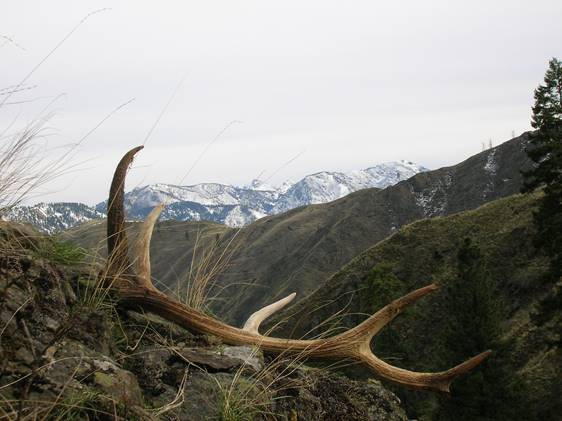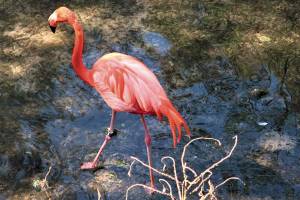“Be the elk.”
That’s the first thing Ray Petersen, an antler hunter for 40 years, told me about successful shed hunting.
“Know where elk feed and rest at the time of year their antlers are shed. And go where no other people are hunting them,” he added.
For Petersen and his wife, Jenny Blaylock, this means spending days hiking steep mountains and glassing ridges and draws, to follow the elevation changes elk make in the transition from winter to spring range when they typically shed their antlers.
“Find the sweet spot,” Petersen said, “between the winter and summer range, where you’re most likely to find elk sheds.”
But, he cautioned, the elevation changes yearly, depending on snow depth, so where elk were last April isn’t a guarantee they’ll be there this year.
Sometimes, according to Petersen, you can visit the same area and find sheds from the same animal several years in a row. Then, something, usually predators or people, cause the elk to move, and your honey-hole comes up empty.
“That’s why it’s called antler hunting, not hiking,” laughed Blaylock. “It’s like regular hunting, but without the gun. You walk slowly and methodically. It’s a completely different mind-set from hiking.”
While April is prime time for elk antler hunting, this formidable team uses late winter to look for whitetail and mule deer sheds as well.
“Whitetail antlers tend to be found in wooded areas with thick brush but in less rugged country,” said Petersen. “We start looking for them in late January.”
Blaylock said mule deer like to hang up high on rimrocks, to really see their surroundings. “We’ve found mule deer antlers in places you’d think were better suited to mountain goats.” The couple begin looking for muley sheds in February.
When Petersen finds a whitetail shed, he scours the area in concentric circles, looking for the match.
“If you find a freshly dropped antler, you almost always find the second one within 200 yards of the first one,” he reported.
But, he added, the smaller the antler, the less likely you’ll find the second one. Sometimes looking in bushes, at the base of trees or next to a windfall will produce an antler.
“Think about where a buck might rub his head to scrape the antlers off,” Petersen recommended.
Blaylock has found antlers behind fence lines and downed trees, where a buck has jumped, and the landing has jarred the antler off.
“Any time you can get elevation and use binoculars to look over open country before grass starts to grow is a good way to cover a lot of ground,” shared Blaylock. “You can go from ridge to ridge, glassing after snow is off, which is why April is good for finding elk sheds: their large size makes successful glassing possible.”
Both Petersen and Blaylock like to ride mountain bikes behind gates closed to motorized traffic to find pristine areas for antler hunting. And when Blaylock rides her horse, she is always on the lookout for antlers.
“I found three antlers riding my horse one day, even though I had hunted the area thoroughly on foot. Being higher up provided the perspective I needed to find the sheds.”
Staying safe is important to this couple. They hunt with backpacks containing food, extra clothes, headlamps, water, and first aid. More often than not, they plan on coming out to a trailhead in the dark. Each of them carries a radio as well, even though they try to stay in sight of one another.
It’s just nicer, they said, to talk quietly into a radio than try to shout to each other and take a chance of scaring animals. In addition, they carry a SPOT emergency communication device that can send out critical injury, health, or rescue information.
Respecting the animals and their environment is an important part of antler hunting.
“We’re very careful not to push animals around when we’re looking for sheds,” said Petersen. “They survived winter, they’re in a depleted physical state, and disturbing single animals or herds is just not ethical.”
It also means, if you are out with your dog, you’ve taught him not to chase wildlife.
Petersen, who often takes week-long to 10-day solo trips, enjoys having his dog along. “A dog is a great companion. If you’re out for a week alone, it’s just nice to have your dog to talk to!”
You can also teach dogs to hunt antlers. “Labs are excellent antler dogs,” said Blaylock, “but you can teach any dog to find them given enough time and training.” The couple is currently training a new puppy by hiding antlers around their property and praising him lavishly when he finds them.
This active couple likes to hike into the backcountry, set up camp, and antler hunt for a week or so.
“It involves a whole lot of walking and several trips to get the antlers out to the trailhead when we are done,” said Blaylock.
With typical loads of 60 to 100 pounds of antlers, they both use meat packs, rather than backpacks, to carry out the sheds. And they both use trekking poles for stability.
“Poles are absolutely essential,” said Blaylock. “You can really get hurt if you fall with a load of sharp antlers on you. And carrying loads in your arms is not a good idea, either.”
The most unique antler Petersen has found was a non-typical, 10-point elk that was heavily palmated (where the prongs join in sheets, resembling the palm of a hand with extended fingers), with heavy mass over all.
Another time he found a honey hole between the Snake and Salmon Rivers with a huge number of antlers that he tied to his bike, which was then too laden to ride. When rain started pouring down, it became too loaded down with mud to push.
“I had to abandon everything and come back again the next day,” he laughed.
Although Blaylock has found a matched pair of seven-point elk antlers, she said her goal is to find a matched set of spikes. “Those smaller elk antlers are almost impossible to find in pairs,” she said. “But, I’m going to keep hunting until I find a set!”
This retired couple stays in shape all year with hiking, riding, and skiing, to be able to enjoy the rugged pastime of antler hunting. They feel blessed to spend so much time in nature, observing animals on public land.
“It’s really like an adult Easter egg hunt,” said Blaylock. “You might not find an antler every time you go out, but when you do, it is a real treasure.”











